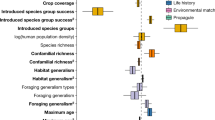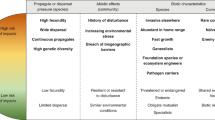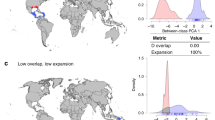Abstract
The unabating rise in the number of species introduced outside of their native range makes predicting the spread of alien species an urgent challenge. Most predictions use models of the ecological niche of a species to identify suitable areas for invasion, but these predictions may have limited accuracy. Here, using the global alien avifauna, we demonstrate an alternative approach for predicting alien spread based on the environmental resistance of the landscape. This approach does not require any information on the ecological niche of the invading species and, instead, uses gradients of biotic similarity among native communities in the invaded region to predict the most likely routes of spread. We show that environmental resistance predicts patterns of spread better than a null model of random dispersal or a model based on climate matching to the native range of each species. Applying this approach to simulate future spread reveals major regional differences in projected invasion risk, shaped by proximity to existing invasion hotspots as well as gradients in environmental resistance. Our results show how environmental resistance may provide a general and complementary approach for predicting invasion risk that can be rapidly deployed even when information on the niche or the identity of potential invaders is unknown.
This is a preview of subscription content, access via your institution
Access options
Access Nature and 54 other Nature Portfolio journals
Get Nature+, our best-value online-access subscription
$29.99 / 30 days
cancel any time
Subscribe to this journal
Receive 12 digital issues and online access to articles
$119.00 per year
only $9.92 per issue
Buy this article
- Purchase on Springer Link
- Instant access to full article PDF
Prices may be subject to local taxes which are calculated during checkout




Similar content being viewed by others
Data availability
All data used in the analysis is available at Figshare (https://doi.org/10.6084/m9.figshare.13270406). Geographical range data for native and alien birds are available from the BirdLife International Data Zone (http://www.datazone.birdlife.org/) and the GAVIA database (https://doi.org/10.1038/sdata.2017.41), respectively. Climate data are available from WorldClim (https://doi.org/10.1002/joc.1276).
Code availability
The code to conduct range spread simulations and to reproduce the analyses is available at Figshare (https://doi.org/10.6084/m9.figshare.13270406).
References
Bellard, C., Cassey, P. & Blackburn, T. M. Alien species as a driver of recent extinctions. Biol. Lett. 12, 20150623 (2016).
Seebens, H. et al. No saturation in the accumulation of alien species worldwide. Nat. Commun. 8, 14435 (2017).
Paini, D. R. et al. Global threat to agriculture from invasive species. Proc. Natl Acad. Sci. USA 113, 7575–7579 (2016).
Bradshaw, C. J. A. et al. Massive yet grossly underestimated global costs of invasive insects. Nat. Commun. 7, 12986 (2016).
Jiménez-Valverde, A. et al. Use of niche models in invasive species risk assessments. Biol. Invasions 13, 2785–2797 (2011).
Barbet-Massin, M., Rome, Q., Villemant, C. & Courchamp, F. Can species distribution models really predict the expansion of invasive species? PLoS ONE 13, e0193085 (2018).
Bellard, C. et al. Will climate change promote future invasions? Glob. Change Biol. 19, 3740–3748 (2013).
Cardador, L. & Blackburn, T. M. A global assessment of human influence on niche shifts and risk predictions of bird invasions. Glob. Ecol. Biogeogr. 29, 1956–1966 (2020).
Petitpierre, B. et al. Climatic niche shifts are rare among terrestrial plant invaders. Science 335, 1344–1348 (2012).
Strubbe, D., Broennimann, O., Chiron, F. & Matthysen, E. Niche conservatism in non-native birds in Europe: niche unfilling rather than niche expansion. Glob. Ecol. Biogeogr. 22, 962–970 (2013).
Liu, C., Wolter, C., Xian, W. & Jeschke, J. M. Most invasive species largely conserve their climatic niche. Proc. Natl Acad. Sci. USA 117, 23643–23651 (2020).
Liu, C., Wolter, C., Xian, W. & Jeschke, J. M. Species distribution models have limited spatial transferability for invasive species. Ecol. Lett. 23, 1682–1692 (2020).
Mothes, C. C., Stroud, J. T., Clements, S. L. & Searcy, C. A. Evaluating ecological niche model accuracy in predicting biotic invasions using South Florida’s exotic lizard community. J. Biogeogr. 46, 432–441 (2019).
Atwater, D. Z., Ervine, C. & Barney, J. N. Climatic niche shifts are common in introduced plants. Nat. Ecol. Evol. 2, 34–43 (2018).
Early, R. & Sax, D. F. Climatic niche shifts between species’ native and naturalized ranges raise concern for ecological forecasts during invasions and climate change. Glob. Ecol. Biogeogr. 23, 1356–1365 (2014).
Parravicini, V., Azzurro, E., Kulbicki, M. & Belmaker, J. Niche shift can impair the ability to predict invasion risk in the marine realm: an illustration using Mediterranean fish invaders. Ecol. Lett. 18, 246–253 (2015).
Gallagher, R. V., Beaumont, L. J., Hughes, L. & Leishman, M. R. Evidence for climatic niche and biome shifts between native and novel ranges in plant species introduced to Australia. J. Ecol. 98, 790–799 (2010).
Hill, M. P., Gallardo, B. & Terblanche, J. S. A global assessment of climatic niche shifts and human influence in insect invasions. Glob. Ecol. Biogeogr. 26, 679–689 (2017).
Lomolino, M. V., Riddle, B. R., Whittaker, R. J. & Brown, J. H. Biogeography (Sinauer Associates Incorporated, 2010).
Nekola, J. C. & White, P. S. The distance decay of similarity in biogeography and ecology. J. Biogeogr. 26, 867–878 (1999).
Rapoport, E. H. Areography: Geographical Strategies of Species (Elsevier Science Limited, 1982)
Graves, G. R. & Rahbek, C. Source pool geometry and the assembly of continental avifaunas. Proc. Natl Acad. Sci. USA 102, 7871–7876 (2005).
Ruggiero, A., Lawton, J. H. & Blackburn, T. M. The geographic ranges of mammalian species in South America: spatial patterns in environmental resistance and anisotropy. J. Biogeogr. 25, 1093–1103 (1998).
Borregaard, M. K., Graves, G. R. & Rahbek, C. Dispersion fields reveal the compositional structure of South American vertebrate assemblages. Nat. Commun. 11, 491 (2020).
Dyer, E. E. et al. The global distribution and drivers of alien bird species richness. PLoS Biol. 15, e2000942 (2017).
Dyer, E. E., Redding, D. W. & Blackburn, T. M. The global avian invasions atlas, a database of alien bird distributions worldwide. Sci. Data 4, 170041 (2017).
Redding, D. W. et al. Location-level processes drive the establishment of alien bird populations worldwide. Nature 571, 103–106 (2019).
Warren, D. L., Glor, R. E. & Turelli, M. Environmental niche equivalency versus conservatism: quantitative approaches to niche evolution. Evolution 62, 2868–2883 (2008).
Bahn, V. & McGill, B. J. Testing the predictive performance of distribution models. Oikos 122, 321–331 (2013).
Beale, C. M., Lennon, J. J. & Gimona, A. Opening the climate envelope reveals no macroscale associations with climate in European birds. Proc. Natl Acad. Sci. USA 105, 14908–14912 (2008).
Abellán, P., Tella, J. L., Carrete, M., Cardador, L. & Anadón, J. D. Climate matching drives spread rate but not establishment success in recent unintentional bird introductions. Proc. Natl Acad. Sci. USA 114, 9385–9390 (2017).
Petitpierre, B., Broennimann, O., Kueffer, C., Daehler, C. & Guisan, A. Selecting predictors to maximize the transferability of species distribution models: lessons from cross-continental plant invasions. Glob. Ecol. Biogeogr. 26, 275–287 (2017).
Early, R. et al. Global threats from invasive alien species in the twenty-first century and national response capacities. Nat. Commun. 7, 12485 (2016).
Bellard, C., Leroy, B., Thuiller, W., Rysman, J. F. & Courchamp, F. Major drivers of invasion risks throughout the world. Ecosphere 7, e01241 (2016).
Fournier, A., Penone, C., Pennino, M. G. & Courchamp, F. Predicting future invaders and future invasions. Proc. Natl Acad. Sci. USA 116, 7905–7910 (2019).
Qiao, H. et al. An evaluation of transferability of ecological niche models. Ecography 42, 521–534 (2019).
Byers, J. E. et al. Invasion expansion: time since introduction best predicts global ranges of marine invaders. Sci. Rep. 5, 12436 (2015).
Dyer, E. E. et al. A global analysis of the determinants of alien geographical range size in birds. Glob. Ecol. Biogeogr. 25, 1346–1355 (2016).
Bird Species Distribution Maps of the World Version 2.0 (BirdLife International and Handbook of the Birds of the World, 2017); http://datazone.birdlife.org/species/requestdis
Meyer, C., Kreft, H., Guralnick, R. & Jetz, W. Global priorities for an effective information basis of biodiversity distributions. Nat. Commun. 6, 8221 (2015).
Pigot, A. L., Owens, I. P. F. & Orme, C. D. L. The environmental limits to geographic range expansion in birds. Ecol. Lett. 13, 705–715 (2010).
Jetz, W. & Rahbek, C. Geometric constraints explain much of the species richness pattern in African birds. Proc. Natl Acad. Sci. USA 98, 5661–5666 (2001).
Hurlbert, A. H. & White, E. P. Disparity between range map- and survey-based analyses of species richness: patterns, processes and implications. Ecol. Lett. 8, 319–327 (2005).
Hijmans, R. J., Cameron, S. E., Parra, J. L., Jones, P. G. & Jarvis, A. Very high resolution interpolated climate surfaces for global land areas. Int. J. Climatol. 25, 1965–1978 (2005).
Jiménez-Valverde, A. et al. Dominant climate influences on North American bird distributions. Glob. Ecol. Biogeogr. 20, 114–118 (2011).
R Core Team R: A Language and Environment for Statistical Computing (R Foundation for Statistical Computing, 2020).
Gentleman, R., Whalen, E., Huber, W. & Falcon, S. graph: A package to handle graph data structures. R package Version 1.68.0 https://bioconductor.org/packages/graph/ (2020).
Csardi G. & Nepusz T. The igraph software package for complex network research. InterJournal, Complex Systems, 1695, 1–9 (2006); https://igraph.org
Koenker, R. quantreg: Quantile regression. R package Version 5.61 http://CRAN.R-project.org/package=quantreg (2020).
Pigot, A. L. et al. Species invasions and the phylogenetic signal in geographical range size. Glob. Ecol. Biogeogr. 27, 1080–1092 (2018).
Acknowledgements
A.L.P. is supported by a Royal Society University Research Fellowship. Initial funding for data collection was provided by a grant from the Leverhulme Trust (no. RF/2/RFG/2010/0016, to E.E.D.), with additional support from a UCL IMPACT studentship (no. 10989, to E.E.D.), a Leverhulme Trust grant (no. RPG-2015-392, to T.M.B., A.L.P. and E.E.D.) and from a King Saud University Distinguished Scientist Research Fellowship (to T.M.B. and E.E.D.).
Author information
Authors and Affiliations
Contributions
R.S.L.L. and A.L.P. conceived the study, performed the analysis, and wrote the first draft of the manuscript. T.M.B. and E.E.D. assembled the alien distribution data. All of the authors contributed to the writing of the final manuscript.
Corresponding author
Ethics declarations
Competing interests
The authors declare no competing interests.
Additional information
Peer review information: Nature Ecology & Evolution thanks the anonymous reviewers for their contribution to the peer review of this work. Peer reviewer reports are available.
Publisher’s note Springer Nature remains neutral with regard to jurisdictional claims in published maps and institutional affiliations.
Extended data
Extended Data Fig. 1 Conceptual illustration of the models used to predict alien spread.
Flowchart illustrating the four types of models used to predict alien spread: Random Dispersal Model, Environmental Resistance (ER) Model, Climate Resistance Model, and Climate Matching Model. Grids show hypothetical probability surfaces used to model spread. The red square indicates the cell where the alien population established. Darker colours indicate that a cell has a higher probability of being invaded. Under the random dispersal model, alien spread is purely stochastic and all cells have an equal probability of being invaded. The other three models use conditions in either the invading species’ alien (red) or native (blue) ranges to guide dispersal. The environmental resistance model uses an invasion probability based on the distributions of native species in the invaded region. The native species with ranges overlapping the cell of alien population establishment are identified, and these species’ ranges are used to calculate the environmental resistance (1 – biotic similarity) to all other cells in the landscape. Biotic similarity is here taken as the proportion of native bird species in the establishment cell that are present at each other cell (yellow box). The climate resistance model calculates the probability of invasion based on the similarity of each cell’s climatic conditions to the conditions within the cell of alien population establishment. Under the climate matching model, invasion probability is determined by a cell’s climatic similarity to the average conditions occupied in the invading species’ native range.
Extended Data Fig. 2 The optimal combination of principal component climate axes for predicting spread in native (rows) and alien (columns) ranges.
For the n = 283 alien species which have spread beyond the cells of initial establishment, the set of climate axes best predicting spread in each alien range fragment (n = 1278) were identified, as well as the set of climate axes best predicting that species’ native range. Each cell in the matrix defined by position (x,y), indicates the number of cases where x is the best model in an alien range fragment and y is the best model in the native range. Diagonal elements indicate cases where the same set of climate axes limit spread in the native and alien ranges of a species. In cases where multiple sets of climate axes predicted spread equally well, fragments were assigned to multiple cells in the matrix but weighted by the inverse of the number of ties. Thus, the sum of the entries in the matrix is equal to the total number of alien range fragments.
Extended Data Fig. 3 Patterns of environmental resistance and climate distance.
For three exemplar focal cells in the (a) Amazon, (b) Sahel and (c) Siberia (Fig. 1), the environmental resistance and climate distance to all other cells was calculated. Environmental resistance is 1-biotic similarity, where biotic similarity is the proportion of species present in the focal cell that are also present in each other cell. Climate distance is the Euclidean distance in four-dimensional climate space between the conditions in the focal cell and each other cell. Bivariate plots show the relationship between the climatic distance and the environmental resistance of each cell relative to the focal cell, and these patterns are shown on the maps below.
Extended Data Fig. 4 The best fitting models across species.
For each species (n = 283), the model with the highest predictive accuracy for the species’ alien range was identified from the following models: random dispersal, environmental resistance, climate matchingOptimal, climate matchingNative, climate resistanceOptimal, climate resistanceNative (Supplementary Table 1). Predictive accuracy was rounded to two decimal places before comparing models to prevent detecting marginal differences in accuracy. Where multiple models had the same predictive accuracy, that species was assigned to multiple models but weighted by the inverse of the number of ties. Thus, the sum of the entries is equal to the total number of species.
Extended Data Fig. 5 Optimal environmental resistance threshold (ERT) for predicting the extent of alien spread at the level of species’ range fragments (n = 1704).
(a) the root-mean-squared error (r.m.s.e.) between simulated and observed alien range size under different ERT values; (b) the optimal ERT for predicting the size of each alien range fragment; (c) for different ERT values, the root-mean-squared error (r.m.s.e.Quantile) between the line of unity and the upper boundary of the relationship between simulated and observed alien range size obtained from a quantile regression (0.99 percentile). In (a,c) the grey dashed line indicates the ERT minimising error.
Extended Data Fig. 6 Predicted against observed range size for different environmental resistance threshold (ERT) values.
Red regions indicate range sizes that are under-predicted. Lines indicate the quantile regression (0.99 percentile) of simulated against observed alien range size. Range size was calculated for individual fragments of species’ ranges (n = 1704 fragments, left column) or for total species range size (n = 339 species, right column). Range size is the number of occupied ~100 km grid cells.
Extended Data Fig. 7 The effect of µ on invasion probability and patterns of spread.
(a) relative probability of invasion as a function of environmental resistance for different values of µ; (b) mean predictive accuracy across species (n = 283) of the environmental resistance model under different values of µ. When µ is high (for example µ = 30), patterns of spread are strongly deterministic. When µ = 0, patterns of spread are independent of environmental resistance, corresponding to the null model of random dispersal. Increasing µ above 30 (marked with an arrow) only resulted in a small increase in model predictive accuracy.
Supplementary information
Rights and permissions
About this article
Cite this article
Lovell, R.S.L., Blackburn, T.M., Dyer, E.E. et al. Environmental resistance predicts the spread of alien species. Nat Ecol Evol 5, 322–329 (2021). https://doi.org/10.1038/s41559-020-01376-x
Received:
Accepted:
Published:
Issue Date:
DOI: https://doi.org/10.1038/s41559-020-01376-x
This article is cited by
-
Mechanistic models project bird invasions with accuracy
Nature Communications (2023)
-
Abrupt expansion of climate change risks for species globally
Nature Ecology & Evolution (2023)
-
Incorporating functional connectivity into species distribution models improves the prediction of invasiveness of an exotic species not at niche equilibrium
Biological Invasions (2023)
-
Biological invasions as a selective filter driving behavioral divergence
Nature Communications (2022)



